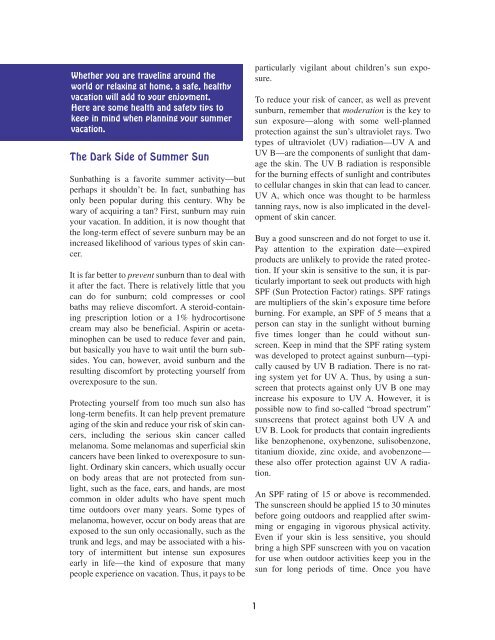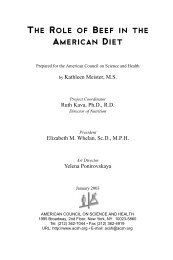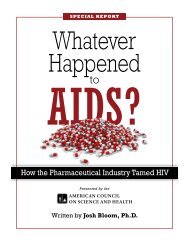View pdf - American Council on Science and Health
View pdf - American Council on Science and Health
View pdf - American Council on Science and Health
You also want an ePaper? Increase the reach of your titles
YUMPU automatically turns print PDFs into web optimized ePapers that Google loves.
Whether you are traveling around the<br />
world or relaxing at home, a safe, healthy<br />
vacati<strong>on</strong> will add to your enjoyment.<br />
Here are some health <strong>and</strong> safety tips to<br />
keep in mind when planning your summer<br />
vacati<strong>on</strong>.<br />
The Dark Side of Summer Sun<br />
Sunbathing is a favorite summer activity—but<br />
perhaps it shouldn’t be. In fact, sunbathing has<br />
<strong>on</strong>ly been popular during this century. Why be<br />
wary of acquiring a tan? First, sunburn may ruin<br />
your vacati<strong>on</strong>. In additi<strong>on</strong>, it is now thought that<br />
the l<strong>on</strong>g-term effect of severe sunburn may be an<br />
increased likelihood of various types of skin cancer.<br />
It is far better to prevent sunburn than to deal with<br />
it after the fact. There is relatively little that you<br />
can do for sunburn; cold compresses or cool<br />
baths may relieve discomfort. A steroid-c<strong>on</strong>taining<br />
prescripti<strong>on</strong> loti<strong>on</strong> or a 1% hydrocortis<strong>on</strong>e<br />
cream may also be beneficial. Aspirin or acetaminophen<br />
can be used to reduce fever <strong>and</strong> pain,<br />
but basically you have to wait until the burn subsides.<br />
You can, however, avoid sunburn <strong>and</strong> the<br />
resulting discomfort by protecting yourself from<br />
overexposure to the sun.<br />
Protecting yourself from too much sun also has<br />
l<strong>on</strong>g-term benefits. It can help prevent premature<br />
aging of the skin <strong>and</strong> reduce your risk of skin cancers,<br />
including the serious skin cancer called<br />
melanoma. Some melanomas <strong>and</strong> superficial skin<br />
cancers have been linked to overexposure to sunlight.<br />
Ordinary skin cancers, which usually occur<br />
<strong>on</strong> body areas that are not protected from sunlight,<br />
such as the face, ears, <strong>and</strong> h<strong>and</strong>s, are most<br />
comm<strong>on</strong> in older adults who have spent much<br />
time outdoors over many years. Some types of<br />
melanoma, however, occur <strong>on</strong> body areas that are<br />
exposed to the sun <strong>on</strong>ly occasi<strong>on</strong>ally, such as the<br />
trunk <strong>and</strong> legs, <strong>and</strong> may be associated with a history<br />
of intermittent but intense sun exposures<br />
early in life—the kind of exposure that many<br />
people experience <strong>on</strong> vacati<strong>on</strong>. Thus, it pays to be<br />
particularly vigilant about children’s sun exposure.<br />
To reduce your risk of cancer, as well as prevent<br />
sunburn, remember that moderati<strong>on</strong> is the key to<br />
sun exposure—al<strong>on</strong>g with some well-planned<br />
protecti<strong>on</strong> against the sun’s ultraviolet rays. Two<br />
types of ultraviolet (UV) radiati<strong>on</strong>—UV A <strong>and</strong><br />
UV B—are the comp<strong>on</strong>ents of sunlight that damage<br />
the skin. The UV B radiati<strong>on</strong> is resp<strong>on</strong>sible<br />
for the burning effects of sunlight <strong>and</strong> c<strong>on</strong>tributes<br />
to cellular changes in skin that can lead to cancer.<br />
UV A, which <strong>on</strong>ce was thought to be harmless<br />
tanning rays, now is also implicated in the development<br />
of skin cancer.<br />
Buy a good sunscreen <strong>and</strong> do not forget to use it.<br />
Pay attenti<strong>on</strong> to the expirati<strong>on</strong> date—expired<br />
products are unlikely to provide the rated protecti<strong>on</strong>.<br />
If your skin is sensitive to the sun, it is particularly<br />
important to seek out products with high<br />
SPF (Sun Protecti<strong>on</strong> Factor) ratings. SPF ratings<br />
are multipliers of the skin’s exposure time before<br />
burning. For example, an SPF of 5 means that a<br />
pers<strong>on</strong> can stay in the sunlight without burning<br />
five times l<strong>on</strong>ger than he could without sunscreen.<br />
Keep in mind that the SPF rating system<br />
was developed to protect against sunburn—typically<br />
caused by UV B radiati<strong>on</strong>. There is no rating<br />
system yet for UV A. Thus, by using a sunscreen<br />
that protects against <strong>on</strong>ly UV B <strong>on</strong>e may<br />
increase his exposure to UV A. However, it is<br />
possible now to find so-called “broad spectrum”<br />
sunscreens that protect against both UV A <strong>and</strong><br />
UV B. Look for products that c<strong>on</strong>tain ingredients<br />
like benzophen<strong>on</strong>e, oxybenz<strong>on</strong>e, sulisobenz<strong>on</strong>e,<br />
titanium dioxide, zinc oxide, <strong>and</strong> avobenz<strong>on</strong>e—<br />
these also offer protecti<strong>on</strong> against UV A radiati<strong>on</strong>.<br />
An SPF rating of 15 or above is recommended.<br />
The sunscreen should be applied 15 to 30 minutes<br />
before going outdoors <strong>and</strong> reapplied after swimming<br />
or engaging in vigorous physical activity.<br />
Even if your skin is less sensitive, you should<br />
bring a high SPF sunscreen with you <strong>on</strong> vacati<strong>on</strong><br />
for use when outdoor activities keep you in the<br />
sun for l<strong>on</strong>g periods of time. Once you have<br />
1










